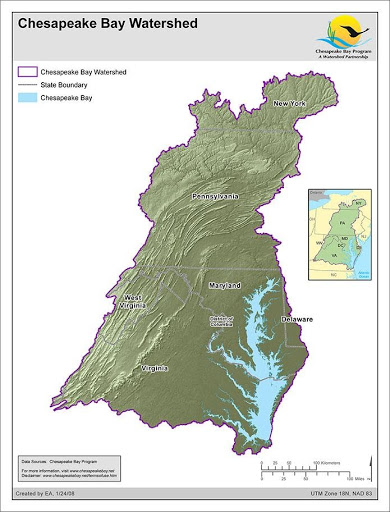Destruction of the Chesapeake Bay’s Diverse Habitats
By Amalia Villegas Vega, Bethesda Green Environmental Leader
Habitat degradation is an urgent issue affecting the Chesapeake Bay today. The three major causes of habitat loss in the bay are increased pollution, development, and climate change (Habitat Degradation). More specific factors caused by humans include changes to land use, excess nutrients sedimentation, overfishing, and invasive species (Environmental factors). It is also imperative to understand that factors with a negative impact don’t always occur directly on the bay. The Chesapeake Bay watershed expands across six states plus DC with about 100,000 tributary rivers and streams (Land Use). The bay itself is susceptible to direct consequences of the pollution of this land and these smaller bodies of water.
In order to understand the issue of habitat destruction, we must first identify the different habitats and ecosystems in the Chesapeake Bay. An ecosystem that may not necessarily be the first thing you associate with the Bay are forests. Forests are essential for a healthy Bay as they provide clean water and air in addition to creating habitats for all kinds of creatures. Next, there are many smaller bodies of water like streams and rivers that have a great impact on the Chesapeake Bay, including being the habitats for various aquatic organisms and providing the Bay with fresh water. Additionally, aquatic reefs are essential in providing animals food and shelter. Wetlands and marshes serve as a transition between water and land and an area on which all types of animals depend for food. Finally, there are the shallows, from the shores up to a depth of 10 feet, that provide fish with food and shelter as well as birds, crabs, and sharks (Ecosystems).
 (Image from Chesapeake Bay Foundation)
(Image from Chesapeake Bay Foundation)
Climate change’s effects on the bay and habitats are also greatly observable. Sea levels are rising around the world and leads to lost shorelines and habitats. According to the Chesapeake Bay Foundation, at least 13 islands have been completely submerged due to these rising sea levels. Sea level has risen as much as a foot in certain areas of the bay leading to the loss of coastal marshes as well as these islands. Salinity and the distribution of freshwater are factors that will change due to these rising sea levels. The Bay continues to be affected detrimentally because of its low height above sea level (Habitat Degradation).
Overall, the entire watershed has tremendous effects on the health of the Bay and these habitats as well. Development on the land, for example, has a negative impact on the forests. The Chesapeake Bay Foundation reports that over 750,000 acres of forest were destroyed for the sake of development between the years of 1982 and 1997. This development is primarily made up of what is called sprawl, poorly and inefficiently planned, which leads to greater polluted runoff. Development throughout the watershed has a negative impact on the Chesapeake Bay (Land use).
 (Image from Chesapeake Bay Program)
(Image from Chesapeake Bay Program)
A particularly important habitat for plants and animals that is at risk is the Chesapeake Bay shoreline. The thousands of miles of shoreline are made up mostly of beaches on the lower Bay (Virginia) and mud flats on the upper Bay (Maryland) (Ecosystems). There have been various attempts to protect and reinforce these shorelines and some have been fairly successful while others have proven to be more detrimental to anything else. The latter are called “armored” shorelines made up of “wooden, concrete or steel bulkhead walls or riprap borders that consist of piles of large stones or boulders” in an attempt to impede shoreline erosion (Waterbirds at Risk). This is a prime example of “Gray Infrastructure,” in which more industrial materials are used. These armored shorelines directly cause habitat loss and destruction as well as negative effects for native species.
There is, however, an alternative to Gray Infrastructure known as Green Infrastructure. The “green” version of armored shorelines are called Living shorelines. Erosion is prevented by the plantation of trees and other vegetation instead of unnatural materials that are not typically found in the Bay. Not only do these living shorelines prevent erosion, but they also improve the overall Bay environment including water quality through filtration, providing habitats, fostering biodiversity, and creating increased levels of oxygen (Living Shorelines).
There are many things you can do to help protect the natural treasure that is the Chesapeake Bay. You can advocate for protection of the Chesapeake Bay and increase of green infrastructure by writing emails and letters to government organizations particularly the Environmental Protection Agency (EPA). There are also many local organizations dedicated to protecting the Chesapeake Bay including Chesapeake Bay Foundation, Chesapeake Bay Program, and Chesapeake Bay Trust. In addition there are various additional ways to help protect the bay including simply picking up trash and planting trees. It is also important to raise awareness and educate others on the importance of protecting the bay. Finally, you can donate and buy a license plate.
Works Cited
Annapolis, M. A. 410 S. A. S. 314, & Us, M. 21403 P.-2470 C. (n.d.-a). Ecosystems—Chesapeake bay(U. S. National park service). Retrieved November 6, 2020, from https://www.nps.gov/cbpo/planyourvisit/ecosystems.htm
Annapolis, M. A. 410 S. A. S. 314, & Us, M. 21403 P.-2470 C. (n.d.-b). Environmental factors—Chesapeake bay(U. S. National park service). Retrieved November 6, 2020, from https://www.nps.gov/cbpo/learn/environmental-factors.htm
Habitat degradation. (n.d.). Retrieved November 6, 2020, from https://www.cbf.org/issues/habitat/index.html
Land use. (n.d.). Retrieved November 6, 2020, from https://www.cbf.org/issues/land-use/index.html
Living Shorelines for the Chesapeake Bay Watershed. (n.d.). Chesapeake Bay Foundation. https://www.cbf.org/document-library/cbf-publications-brochures-articles/Living_Shorelines011a.pdf
Waterbirds at Risk in the Chesapeake Bay. (2018, March 1). U.S. Geological Survey. www.usgs.gov/news/waterbirds-risk-chesapeake-bay
About the author:
 Amalia Villegas Vega, Bethesda Green Environmental Leader
Amalia Villegas Vega, Bethesda Green Environmental Leader
Amalia Villegas Vega is a Senior at St. John’s College High School. She is passionate about protecting the environment and is looking forward to making local change with Bethesda Green. Her passions other than the environment include music, theater, and journalism.





